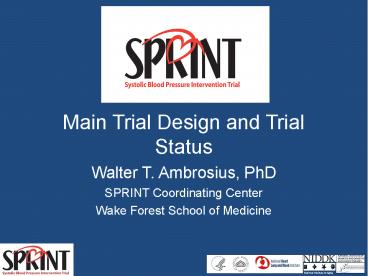Main Trial Design and Trial Status - PowerPoint PPT Presentation
Title:
Main Trial Design and Trial Status
Description:
Main Trial Design and Trial Status Walter T. Ambrosius, PhD SPRINT Coordinating Center Wake Forest School of Medicine American Society of Hypertension, Inc. (ASH ... – PowerPoint PPT presentation
Number of Views:221
Avg rating:3.0/5.0
Title: Main Trial Design and Trial Status
1
- Main Trial Design and Trial Status
- Walter T. Ambrosius, PhD
- SPRINT Coordinating Center
- Wake Forest School of Medicine
2
American Society of Hypertension, Inc. (ASH)
- Disclosure of Relationships
Over the past 12 months
Over the last 12 months, Walter T. Ambrosius,
PhD, has received research support from the
National Heart, Lung, and Blood Institute
(NHLBI), the National Eye Institute (NEI), the
National Institute of Diabetes and Digestive and
Kidney Diseases (NIDDK), and the National
Institute on Aging (NIA) of the National
Institutes of Health (NIH).
3
Outline
- SPRINT Locations
- SPRINT Outcomes
- Primary and secondary analyses
- Subgroups
- Event rate justification
- Sample size calculations
- Power summary
- Ancillary studies
- Current recruitment status
4
SPRINT Networks and Sites
5
Primary Outcome Composite (CVD)
- CVD mortality
- Myocardial infarction
- Non-MI acute coronary syndrome
- Stroke
- Heart Failure
6
Key Secondary Objectives
- Total mortality
- Progression of CKD
- Probable dementia
- Cognitive impairment
- White matter lesions detected by MRI
7
Other Planned Analyses
- Achieved blood pressure
- Adverse events
- Health related quality of life
- Cost
- Various laboratory assays
- Chemistry profile, fasting glucose, lipid profile
8
Primary Analysis
- Primary analysis will use a Cox proportional
hazards model (time to event) - Stratified by clinical site
- Intention to treat principle will be used
9
Subgroups
- Motivated by biologically plausible hypotheses
- CKD vs. non-CKD
- lt75 vs. 75 years of age
- Black vs. non-black
- Others
- CVD vs. no prior CVD
- Gender
- SBP tertiles at baseline
10
Primary Outcomes in Subgroups
- Formal tests within subgroups are not planned
- Interactions between subgroup indicators and
intervention arm will be tested - Regardless of interaction test, overall
conclusion applies to all subgroups
11
Event Rate Calculations for Primary Outcome
- Based on ALLHAT data provided by ALLHAT, all
three arms not stopped early, without diabetes at
baseline - 4.39 /yr (using hospitalized angina rather than
non-MI ACS) - Need to modify the rate for the SPRINT population
12
Modifications from ALLHAT
- Factors increasing event rate
- SPRINT will have older participants
- Use of Framingham risk score of 15
- Oversampling of stage 3 and 4 CKD
- Factors decreasing event rate
- Temporal trend towards reduced rate in other
studies - More rigorous definition of non-MI ACS
- Exact impact of these is unclear
- To be conservative, we halved ALLHATs rate and
assumed 2.2 /yr
13
Comparison to ACCORD
- ACCORD event rate was 2.09 /yr in standard BP
and 1.87 /yr in intensive BP - ACCORD
- Excluded people with CKD due to concerns about
metformin for glycemia question - Did not recruit age gt80 years in the main trial
- Lipid trial enrolled almost all people with low
HDL, excluding these high risk people from the BP
trial - Did not include non-fatal heart failure or non-MI
acute coronary syndrome - Thus, we believe SPRINT will have a higher event
rate than ACCORD
14
SPRINT Assumptions
- The event rate for the SPRINT composite outcome
is - 2.2 /yr in the standard BP arm
- 4 /yr for standard BP participants with eGFR lt60
ml/min/1.73m2 - 3.5 /yr for standard BP participants 75 years
old
15
SPRINT Assumptions, Cont.
- Sample sizes
- 9250 participants in SPRINT (primary outcome and
incident dementia) - 4300 participants with eGFR lt 60 ml/min/1.73m2
- 3250 participants 75 years old
- Uniform recruitment over 2 years
- Minimum follow-up is 3 years, 10 months (assumes
that closeout visits occur uniformly over a 4
month period) - Two-sided tests at the 0.05 level are used
- Annual loss to follow-up is 2 /yr
- 3 /yr for incident dementia
16
SPRINT Power Summary Primary Outcomes
- 88.7 power to detect a treatment effect of 20
of intensive BP vs. standard BP - 81.9 power to detect a treatment effect of 20
of intensive BP vs. standard BP among
participants with eGFR of lt60 ml/min/1.73m2 at
baseline - 84.5 power to detect a treatment effect of 25
of intensive BP vs. standard BP among
participants at least 75 years old at baseline
17
Funded Ancillary Studies
- SPRINT FAST (Factors affecting Atherosclerosis
Study), Srini Beddhu, MD, University of Utah
(NIDDK) - MYH9 and other validated CKD genes in SPRINT,
Barry Freedman, MD, Wake Forest (NIDDK) - SPRINT HEART, Dalane Kitzman, MD, Wake Forest
(NHLBI) - Reduction in Pulse wave velocity as a predictor
of CV outcomes in SPRINT, Mark Supiano, MD, U of
Utah (NHLBI) - SPRINT MIND The Kidneys, Manju Tamura, MD,
Stanford (NIDDK)
18
Current Trial Status
- DSMB has evaluated enrollment and adherence and
recommended continuation - Currently recruiting at or above our weekly
target - Anticipate meeting our target of 9250, over 58
complete
19
Take Home Message
- SPRINT is a randomized clinical trial of systolic
blood pressure lowering from usual goal to
lower-than-usual goal in 9250 participants with
88.7 power to detect a 20 reduction in the
primary composite CVD outcome
20
American Society of Hypertension, Inc. (ASH)
- Disclosure of Relationships
Over the past 12 months
Over the last 12 months, Walter T. Ambrosius,
PhD, has received research support from the
National Heart, Lung, and Blood Institute
(NHLBI), the National Eye Institute (NEI), the
National Institute of Diabetes and Digestive and
Kidney Diseases (NIDDK), and the National
Institute on Aging (NIA) of the National
Institutes of Health (NIH).































